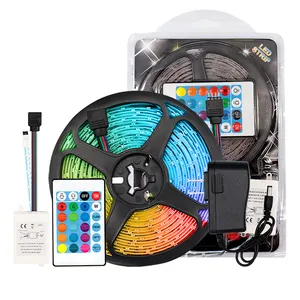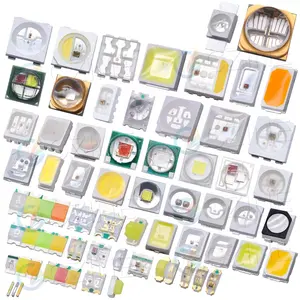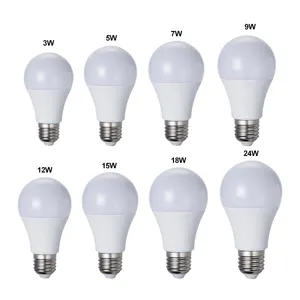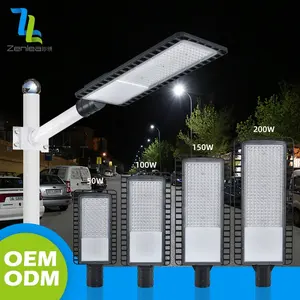Introduction
In the realm of modern lighting, Surface Mount LEDs (SMDs) have emerged as a versatile and efficient solution. This article serves as your ultimate guide to understanding and choosing the best SMD lights for your needs. We delve into the intricacies of SMD lights, exploring their structure, types, and the leading industry manufacturers. We also guide you through the process of selecting the most suitable SMD lights, considering factors like brightness, color temperature, energy efficiency, durability, cost, and installation. Safety precautions and maintenance tips are also covered to ensure you get the most out of your SMD lights.
Understanding SMD Lights
Surface Mount LEDs, also known as SMDs, are diodes that can be placed on a substrate or circuit board, with a silicon dome over the diode for protection. They are available in high-power versions from industry leaders. High Power LEDs come as bare emitters or are mounted to a Metal Core Printed Circuit Board (MCPCB). The boards are insulated and contain conductive tracks for easy circuit connections. SMDs are known for their high light outputs and efficiency, making them a popular choice for various lighting applications.
Types of SMD Lights
SMD lights come in various types, each with unique characteristics. The SMD 3528 LED diodes are older models, primarily used in decorative lighting due to their low cost. The SMD 2835 diodes are more recent, offering greater efficiency and a higher density of diodes. SMD 5050 LEDs deliver adequate power for general lighting needs, but they can create a 'dotted' effect due to the low number of diodes per meter. SMD 5630 and 5730 diodes are known for their high brightness, making them suitable for professional lighting. Lastly, the SMD 2110 LED diodes, the most recent, can be mounted very close together, creating a continuous light effect.
3528 SMD
The 3528 SMD is a smaller LED chip, measuring 3.5mm x 2.8mm. It's commonly used in LED tapes with 60 LEDs per metre, consuming 4.8w at 12v. This SMD provides a smooth, bright effect with a lumen output of around 330-360 lumens per metre. It's available in various colors and is ideal for feature lighting. There's also a double power 3528 SMD, which draws double the power and gives off double the output, ideal for areas requiring more ambient light.
5050 SMD
The 5050 SMD LED is a versatile lighting solution used in various applications like home illumination, interior lighting, and automobile lighting. These strips offer optimal color consistency, luminous flux, and efficacy, adhering to safety standards. They are easily mountable, engineered to dissipate heat, and reduce voltage drop. With a proven record of stability, reliability, and efficiency, these LED strips are ideal for commercial, residential, stage & studio, theatrical, and specialized lighting designs.
5630 SMD
5630 SMD LEDs are the brightest among the 3528 and 5050 types, not just due to a larger lighting surface, but also due to the chip design and power draw. They are highly adaptable for various projects, as they can be dimmed to the required level. Running 5630 LEDs below their maximum settings can significantly prolong their lifespan. We use genuine LED diodes for our 5630 LEDs due to their superior quality, reliability, and value.
How to Choose the Best SMD Lights
Choosing the best SMD LED involves understanding your application, considering factors like brightness, color, forward voltage, viewing angle, forward current, package size, thermal management, lifespan, dimming compatibility, and environmental conditions. It's crucial to check datasheets for detailed technical information, select a reputable manufacturer, and sample and test before bulk purchasing. Quantity, pricing, and proper integration are also key considerations. Remember, the right SMD LED balances technical specifications, performance requirements, and budget considerations.
Brightness and Color Temperature
Understanding the color temperature of SMD lights is crucial when choosing the right product. LED light sources, including SMD lights, are based on the Kelvin system of measure. A warm color temperature is typically 3,000K or less, providing a cozy, inviting light. A 'cool' white bulb commonly has a color temperature of 4,000K and higher on the Kelvin scale, offering a more energizing, bright light. The color temperature you choose depends on the desired ambiance and application of the SMD light.
Energy Efficiency
SMD LED chips have evolved significantly, offering various sizes and shapes. Their luminous efficacy, expressed in Lumens per Watt (lm/W), is a key measure of their energy efficiency. The maximum theoretical efficiency of an ideal light source is 683 lm/W at a 555 nm green color wavelength. However, white light LEDs have a maximum theoretical efficacy of around 350 lm/W. Efficiency varies by chip type, with some like the 3535, 2016, and 2835 types being particularly efficient. Remember, driving high-power chips at 40-50% of their nominal power rating usually produces peak efficacy.
Durability and Lifespan
The durability and lifespan of SMD lights, like LEDs, are influenced by several factors. Intense heat exposure can dramatically reduce their lifespan. To prolong their lifespan, turn SMD lights off when not in use. Running them on higher currents than recommended can shorten their lifespans. SMD lights with well-designed heat sinks may last longer. If your SMD light burns out prematurely, check its manufacturer’s warranty or guarantee.
Cost Considerations
The cost of SMD lights varies depending on the type and quality. While the initial cost might be higher than traditional lighting, these long-lasting and highly-durable lights save significant energy and, therefore, money over time. For instance, replacing incandescent bulbs with SMD lights can lead to substantial savings on your energy bills. Moreover, the cost of professional installation can also affect the overall expenses. Therefore, it's crucial to consider both the upfront and long-term costs when choosing SMD lights.
Installing and Using SMD Lights
Installing SMD lights, like LED strip lights, requires a clean, dry surface for adherence. The lights are unrolled from a spool, and the adhesive backing is used to stick them to the desired surface. To ensure a firm grip, you can use fixing clips. Once secured, the strip lights are connected to a controller and power adapter, then plugged into an electrical outlet. For complex designs, connectors and connector clips can be used to join strip light sections, allowing for twists, turns, and even coverage over uneven surfaces.
Safety Precautions
When installing SMD lights, safety is paramount. Always check for signs of damage such as cracks, exposed wiring, or broken diodes. Ensure the location of the lights is safe and not overcrowded with flammable materials. If replacing existing bulbs, turn off the electrical current first. For outdoor installations, protect cords from elements and keep outlets away from water. In case of an emergency, cut the power immediately and call for professional help.
Maintenance Tips
LED lights, including SMD lights, require regular maintenance to extend their lifespan. Investing in quality products minimizes maintenance costs. Regular cleaning is essential as dust and debris can cause shortages. The environment, including working and storing temperatures, significantly impacts the LED lights' lifespan. Too hot or too wet conditions can decrease their working time. Regular inspections and usage checks are also crucial for early detection and repair of any issues.
Conclusion
SMD lights, with their high light outputs and efficiency, have revolutionized the lighting industry. From the older 3528 models to the latest 2110 diodes, each type offers unique characteristics suitable for various applications. The choice of SMD light depends on a balance of technical specifications, performance requirements, and budget considerations. Understanding color temperature, energy efficiency, and durability can help you make an informed decision. While installation and maintenance may seem daunting, with the right safety precautions and regular upkeep, SMD lights can provide a long-lasting, cost-effective, and versatile lighting solution.





























 浙公网安备 33010002000092号
浙公网安备 33010002000092号 浙B2-20120091-4
浙B2-20120091-4